The 2011 MacBook Air (11 & 13-inch): Thoroughly Reviewed
by Anand Lal Shimpi on July 28, 2011 3:25 AM EST- Posted in
- Apple
- Mac
- Intel
- Sandy Bridge
- MacBook Air
- Laptops
A New Thunderbolt Implementation
The other major change to the new MacBook Air is support for Intel's new Thunderbolt interface. We first met Thunderbolt on the 2011 MacBook Pro and saw it again on the iMac. Both the new Mac mini and the MacBook Air now support Thunderbolt as well, although the Air's implementation is slightly different.
If you look at iFixit's teardown of the new 13-inch MacBook Air you'll notice the absence of the traditional flip-chip Thunderbolt controller from the MacBook Pro, iMac and Mac mini. In fact, there are only two flip-chip parts on the motherboard - the Core i5 and the QS67 chipset.

13-inch MacBook Air (Mid 2011) Motherboard, QS67 (left), Intel Core i5 (right) - Courtesy iFixit
iFixit assumed that the QS67 chipset integrated Intel's Thunderbolt controller. Unfortunately there are a couple of things wrong with this assumption. First off, Intel has already announced that Thunderbolt wouldn't even be integrated in Ivy Bridge chipsets next year. While it's possible that Apple could request a special chipset from Intel, Apple would have to pay for the added design, manufacturing and validation costs or commit to huge volume numbers in order to make the effort worthwhile for Intel.
The second problem with the assumption has to do with the QS67 die itself. It looks unchanged from the square 6-series chipset die we saw back at CES earlier this year:
I didn't measure the two but they do look awfully similar. It's far more likely that the Thunderbolt controller is simply elsewhere on the motherboard. But where?
In all existing Thunderbolt Macs, the controller is very close to the Thunderbolt port. Looking carefully at the new MacBook Air you'll notice a tiny Intel chip near the Thunderbolt port:

Intel's Eagle Ridge SFF Thunderbolt Controller - Courtesy iFixit
This is a brand new Thunderbolt controller from Intel - codenamed Eagle Ridge. The chip used in the MacBook Pro, iMac and Mac mini is called Light Ridge and it looks like this:
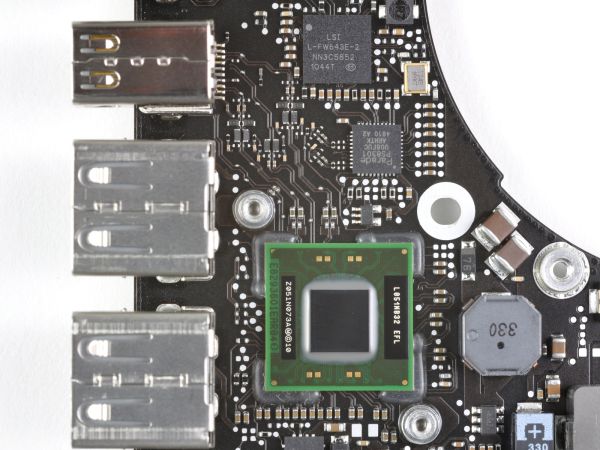
Light Ridge Thunderbolt Controller IC on 15" 2011 MacBook Pro - Courtesy iFixit
Light Ridge supports four bidirectional 10Gbps channels (20Gbps total per channel) channels and two DisplayPort inputs/outputs. On the iMac it's used to drive two ports on the back of the system.
Eagle Ridge is half of Light Ridge. You get two bidirectional 10Gbps channels (20Gbps total per channel) and one DisplayPort input/output. Eagle Ridge is offered in both a normal and small form factor package, the SFF version is what's used in the MacBook Air. I suspect Eagle Ridge is the cost reduced version of Intel's Thunderbolt controller Apple needed to maintain profit margins while bringing out a $999 MacBook Air with Thunderbolt.
Both the 11 and 13-inch MacBook Air have a single Thunderbolt port. This port is on the right side of both machines in the same location as the miniDP receptacle in last year's model.
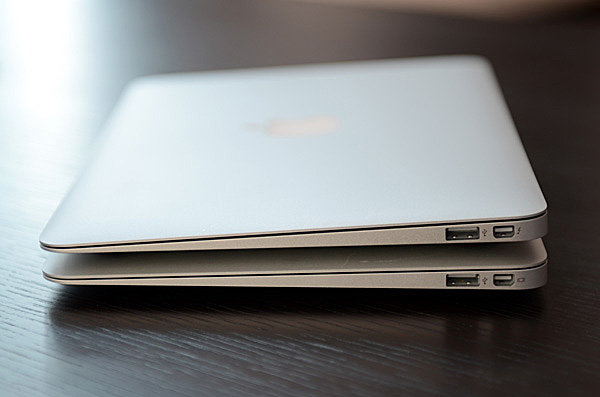
The Thunderbolt port on the new 11 (top)
I already mentioned that functionally Thunderbolt in the MacBook Air is no different than in the MacBook Pro. A quick visit to Windows 7's device manager confirms that the Thunderbolt controller branches off of the CPU's on-die PCIe controller:
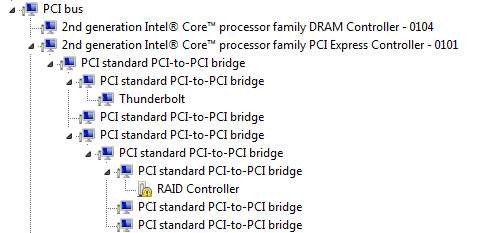
The unidentified RAID device is a Promise Pegasus R6, which still lacks driver support under Windows. With no discrete GPU in the MacBook Air there are more than enough PCIe lanes for Thunderbolt, but this controller still only uses (and needs) 4 of them.
Both DisplayPort and PCIe are carried over to the Thunderbolt port on the system. Apple clarified that you can in fact mix video and PCIe traffic on a single channel or across multiple channels. This gives you 20Gbps of upstream bandwidth and 20Gbps of downstream bandwidth to use however you want. Remember that driving a single 27-inch 25x14 display uses up around 7Gbps of upstream bandwidth alone, but there's still more than enough for storage and other needs.
I tested the Pegasus R6 with both MacBook Airs and its performance was similar to the MacBook Pro:
| Promise Pegasus R6 12TB (10TB RAID-5) Performance | ||||||
| Sequential Read | Sequential Write | 4KB Random Read (QD16) | 4KB Random Write (QD16) | |||
| 15-inch MacBook Pro (Early 2011) | 673.7 MB/s | 683.9 MB/s | 1.24 MB/s | 0.98 MB/s | ||
| 13-inch MacBook Air (Mid 2011) | 647.4 MB/s | 724.9 MB/s | 1.38 MB/s | 1.37 MB/s | ||
| 11-inch MacBook Air (Mid 2011) | 627.6 MB/s | 723.3 MB/s | 1.37 MB/s | 1.37 MB/s | ||
Write speeds were a bit higher but I suspect that has more to do with changes to performance under Lion than anything inherent in the hardware.
Thunderbolt devices appear under System Profiler the same way they do on the MacBook Pro:

The Thunderbolt port can also function as a miniDP output which works as expected on the Air. UI performance is ok on a 27-inch Cinema Display driven by a MacBook Air despite the lack of a dedicated high speed frame buffer. The biggest issue is that firing up Mission Control or swiping between Spaces is met with a significantly reduced frame rate. If you're going to be using a high resolution external panel regularly, you might want to consider a MacBook Pro with a lot of dedicated video memory.
Note that the Air can only drive a single external display. Not only does the Eagle Ridge Thunderbolt controller only support one DisplayPort output but Intel's HD 3000 GPU only supports two display outputs and one is already occupied by the Air's panel.
The Thunderbolt Display
Neither MacBook Air has an integrated Ethernet controller, there's no need as neither system is physically thick enough to accommodate a standard RJ45 connector. Apple has sold a USB 10/100 Ethernet dongle in the past for MacBook Air owners, but these days you can get better performance over good WiFi than you can from 100Mbps Ethernet. This is where that magical Thunderbolt port comes into play.
Remember Thunderbolt is just a carrier for PCI Express and DisplayPort. Any device that lives off of a PCIe bus can in theory be used over Thunderbolt. Typically your GigE controller is a PCIe device that resides on your motherboard. Sonnet took a PCIe Gigabit Ethernet controller, put it in a small box along with a Thunderbolt controller and built this:
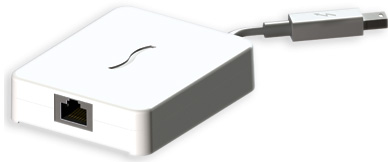
The Presto Gigabit Ethernet Thunderbolt Adapter is all you'd need to add GigE support to the MacBook Air. Need FireWire 800 support? Sonnet announced one of those too:
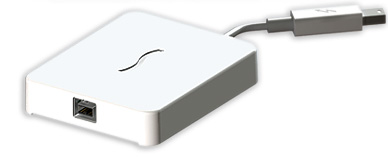
There's a total of 20Gbps of bandwidth in either direction over Thunderbolt, which is more than enough for 1Gbps of traffic over Ethernet or 800Mbps of traffic over Firewire. Availability is slated for "this summer" for both of these devices.
Rather than building individual cables, Apple did almost exactly what I asked for and built a monitor with more IO. It's called the Thunderbolt Display and it features an integrated USB 2.0, FireWire 800, Gigabit Ethernet and audio controller. All of these controllers reside on PCIe and are tunneled over to the host Mac via a single Thunderbolt cable.
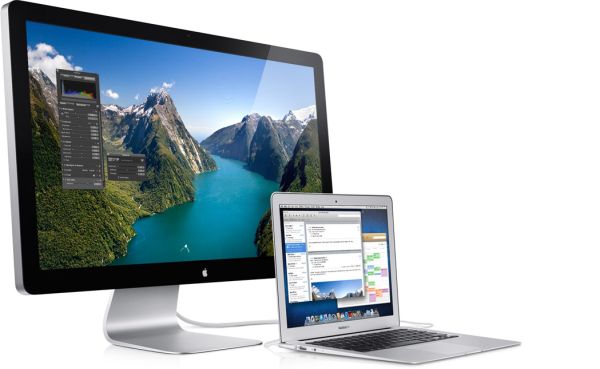
While the MacBook Air doesn't support FireWire 800 or Gigabit Ethernet, paired with a dongle, breakout box or Thunderbolt Display you can add those options presumably without giving up performance.
This is what Thunderbolt was meant to do. All we need now is widespread adoption, more accessories and a standard for external GPU form factors.


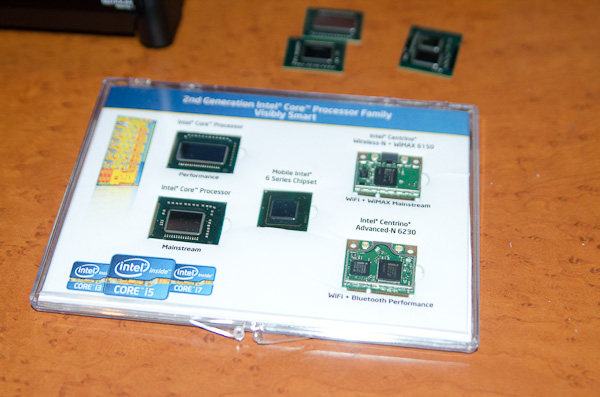








103 Comments
View All Comments
mschira - Friday, July 29, 2011 - link
well you are not thinking apple enough for this. saving 100$ is no reason accepting a mess on your table...besides who sais you need to toss the display when the gfx is outdated? what's keeping you from connecting the display via A dedicated GPU box once the internal GPU becomes to slow?
M.
darwinosx - Saturday, July 30, 2011 - link
In the display? So when the card is obsolete you get a new display? How about outside the laptop and the display but in between both.AJ Driver - Thursday, July 28, 2011 - link
Thanks Anand :)The irony for me reading your review and others around the internet is the comparison in performance between these MBAs and other models (both new and old).
My personal laptop is a 5, going on 6, year old Macbook and for what I use it for it's more than good enough. It's pretty incredible the way technology is advancing, and if the current pc stays the course I wait as long as I can before taking the leap.
It's hard to deny the urge to upgrade though!
Marand - Thursday, July 28, 2011 - link
Well I thought I was finally clear that I was going to buy a MacBook Pro 13 but now I am not so sure.I mainly use my laptop for software development. My previous one was MacBook pro 2007 model which served me well.
My issue with the pro line is that because of their weight, it just ends up becoming a desktop that I don't take with with me and always plugged into a large screen.
But having the ability to put 8 gigs of ram and update the hard drive on the new MBPro is a nice option to have.
I really hoped that apple was going to release MBAs with 8 gigs of ram at least and even if you can't upgrade the hard drive (although I heard you can with prev gen from OWC) you could always plug in bigger drives through thunderbolt if and when drives comes out.
The big selling factor for the MBA for me was the weight. I figured it would be super easy to take with me where and when I want without treating it like a desktop.
I know the MBAs are not targeted to developers. Ut I know plenty who were hoping for "more" from MBA
So now I have a tough choice because the MBpro 15 with quad core and the hi res anti glare screen is packed with power even if it's heavier and likely has more long term capability.
Oh well, can't have it all I guess...
A5 - Thursday, July 28, 2011 - link
If the 15" MBP is too heavy for you, you may want to get a more supportive bag or something. I would've killed for a 5.6lb 15" laptop 8 years ago :PUritziel - Thursday, July 28, 2011 - link
Remember, you're not supposed to carry it around attached to your ear lobe :)I carried a 17-inch DTR laptop that weighed about 10 lbs. around campus for a year, so 5.6 lbs. sounds light to me too. I consider battery life as the main metric of portability after weight hits that 5 lbs. mark.
crimson117 - Thursday, July 28, 2011 - link
>The only exception is if you're just going to spend your time doing very basic tasks on the machine and plan on upgrading again in a year or two. If that's the case save your money and enjoy a 4GB version with Ivy Bridge next year.People who can afford a new MacBook Air every time a new one comes out aren't going to be worried about saving their money on a ram upgrade :)
steven75 - Thursday, July 28, 2011 - link
Apple hardware has incredible resale value, so it's actually easier to do than you think.Uritziel - Thursday, July 28, 2011 - link
Don't forget that if you buy a laptop for $2000 today and sell it at that great Apple resale value of say $1000 (numbers are random) in a few years when you're ready to upgrade, the laptop did NOT cost $1000 in the end.Adding on the effort required to resell it, that rationale makes a lot less sense than some people claim.
Rasterman - Wednesday, August 3, 2011 - link
I'm looking at upgrading right now so I looked up the resale value of mine. I bought a new MB for $1150 in 2008, used prices are $500-$800 right now, I expect to sell mine north of $700 since it is in brand new condition as I only used it as a dev machine when porting and it has seen very little use. So my expected resale value is 61% after 3 years which is pretty damn good IMO.